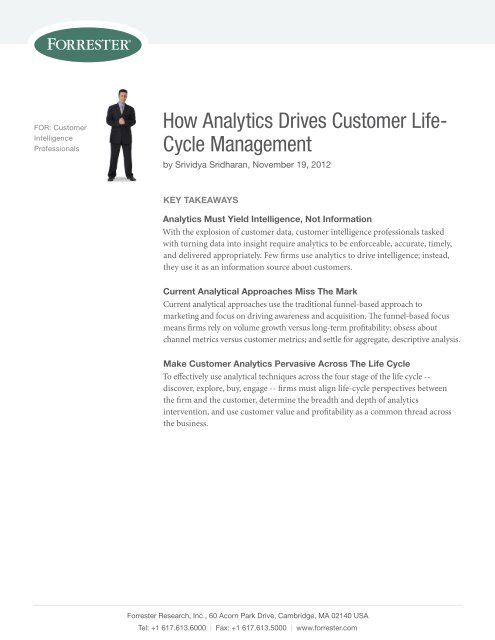How Analytics Drives Customer Life- Cycle ... - Prepaid MVNO
How Analytics Drives Customer Life- Cycle ... - Prepaid MVNO
How Analytics Drives Customer Life- Cycle ... - Prepaid MVNO
Create successful ePaper yourself
Turn your PDF publications into a flip-book with our unique Google optimized e-Paper software.
FOR: <strong>Customer</strong><br />
Intelligence<br />
Professionals<br />
<strong>How</strong> <strong>Analytics</strong> <strong>Drives</strong> <strong>Customer</strong> <strong>Life</strong>-<br />
<strong>Cycle</strong> Management<br />
by srividya sridharan, november 19, 2012<br />
key TakeaWays<br />
analytics Must yield intelligence, Not information<br />
With the explosion of customer data, customer intelligence professionals tasked<br />
with turning data into insight require analytics to be enforceable, accurate, timely,<br />
and delivered appropriately. Few firms use analytics to drive intelligence; instead,<br />
they use it as an information source about customers.<br />
Current analytical approaches Miss The Mark<br />
Current analytical approaches use the traditional funnel-based approach to<br />
marketing and focus on driving awareness and acquisition. The funnel-based focus<br />
means firms rely on volume growth versus long-term profitability; obsess about<br />
channel metrics versus customer metrics; and settle for aggregate, descriptive analysis.<br />
Make <strong>Customer</strong> analytics pervasive across The <strong>Life</strong> <strong>Cycle</strong><br />
To effectively use analytical techniques across the four stage of the life cycle --<br />
discover, explore, buy, engage -- firms must align life-cycle perspectives between<br />
the firm and the customer, determine the breadth and depth of analytics<br />
intervention, and use customer value and profitability as a common thread across<br />
the business.<br />
Forrester Research, Inc., 60 Acorn Park Drive, Cambridge, mA 02140 UsA<br />
Tel: +1 617.613.6000 | Fax: +1 617.613.5000 | www.forrester.com
For <strong>Customer</strong> Intelligence Professionals<br />
November 19, 2012<br />
<strong>How</strong> <strong>Analytics</strong> <strong>Drives</strong> <strong>Customer</strong> <strong>Life</strong>-<strong>Cycle</strong><br />
Management<br />
Vision: The <strong>Customer</strong> <strong>Analytics</strong> Playbook<br />
by Srividya Sridharan<br />
with Dave Frankland, Suresh Vittal and Allison Smith<br />
Why Read This Report<br />
With the growing importance of customer intelligence (CI) in organizations, the role of analytics to extract<br />
insight and embed it back into organizational processes is at the forefront of business transformation.<br />
<strong>How</strong>ever, marketers predominantly enable measurement and analytics infrastructure to serve the needs<br />
of customer acquisition, with a limited view toward the entire customer life cycle. Forrester recommends<br />
deploying various analytical techniques across the customer life cycle to grow existing customer<br />
relationships and provide insight into future behavior. This report of the customer analytics playbook is an<br />
update to the report of the same title, originally published on July 29, 2011. It has been updated to include<br />
recent survey data and new client examples.<br />
Table Of Contents<br />
2<br />
3<br />
3<br />
<strong>Analytics</strong> Must Yield Intelligence, Not<br />
Information<br />
Current Analytical Approaches Miss The<br />
Mark<br />
Make <strong>Customer</strong> <strong>Analytics</strong> Pervasive Across<br />
The <strong>Life</strong> <strong>Cycle</strong><br />
Discover: Begin With <strong>Analytics</strong> To Gain<br />
<strong>Customer</strong> Understanding<br />
Explore: Adapt Marketing Parameters To<br />
<strong>Customer</strong> Response<br />
Buy: Enhance Historical Insight With Forward-<br />
Looking Analysis<br />
Notes & Resources<br />
Forrester interviewed scores of user and<br />
vendor companies, including Acxiom,<br />
Brookstone, Corona Direct, Farmers<br />
Insurance Group, IBM SPSS, IBM Unica,<br />
Intuit, and Pitney Bowes.<br />
Related Research Documents<br />
It’s Time To Bury The Marketing Funnel<br />
October 28, 2010<br />
The Intelligence Approach To <strong>Customer</strong><br />
Intelligence<br />
October 16, 2009<br />
10<br />
Engage: Elevate <strong>Analytics</strong> To Drive <strong>Customer</strong><br />
Development And Retention<br />
recommendations<br />
Map Out <strong>Analytics</strong> Requirements At Each<br />
<strong>Life</strong>-<strong>Cycle</strong> Stage<br />
11<br />
Supplemental Material<br />
© 2012, Forrester Research, Inc. All rights reserved. Unauthorized reproduction is strictly prohibited. Information is based on best available<br />
resources. Opinions reflect judgment at the time and are subject to change. Forrester ® , Technographics ® , Forrester Wave, RoleView, TechRadar,<br />
and Total Economic Impact are trademarks of Forrester Research, Inc. All other trademarks are the property of their respective companies. To<br />
purchase reprints of this document, please email clientsupport@forrester.com. For additional information, go to www.forrester.com.
For <strong>Customer</strong> Intelligence Professionals<br />
<strong>How</strong> <strong>Analytics</strong> <strong>Drives</strong> <strong>Customer</strong> <strong>Life</strong>-<strong>Cycle</strong> Management 2<br />
ANALYTICS MUST YIELD INTELLIGENCE, NOT INFORMATION<br />
The age of the customer is a reality, radically changing the way customers interact with firms.<br />
Trends such as the rise of the splinternet, the increase in mobility, and unlimited storage create<br />
more customer data than ever before. Firms that focus their budgets toward customer knowledge<br />
and relationships will thrive in this environment. But few firms have tapped into the intelligence<br />
zeitgeist. <strong>Customer</strong> intelligence professionals — those tasked with turning this multitude of data<br />
into insights — require analytics with:<br />
■ Enforceability to drive business results. CI professionals who use analytics to drive business<br />
results rather than to support a reactive reporting role do not tolerate nice-to-know insights<br />
like “high-value customers tend to buy less frequently.” As a senior marketer at a large insurance<br />
company puts it, “Much of the work of the strategy and analytics group at our company is<br />
reactive, not proactive — very connected to specific events, but business operators using the<br />
insight were not engaged in driving the action.”<br />
■ Accuracy to instill confidence in the output of analytics. Firms frequently make marketing<br />
decisions such as new product innovation, channel selection, and media buying based on customer<br />
data. Bottom line? Reliable insights are a planning necessity, not a one-off luxury. An interactive<br />
marketer at a leading health insurance company told us that his first priority, in an effort to boost<br />
stakeholder confidence, was to ensure data integrity from various interactive channels and verify<br />
accuracy at any given point in time — especially important in a regulated industry.<br />
■ Speed and timeliness to ensure relevance at the point of interaction. To keep up with<br />
attention-strapped customers, CI professionals must equip themselves with insights at a<br />
faster pace. The timely delivery of insights depends heavily on the technology and process<br />
infrastructure. But equally important is the relevance of insights at the point of customer<br />
interaction. 1 For example, a leading hotel chain uses scored customer data to deliver timely,<br />
relevant messages to customers at every point of interaction, from the call center to the<br />
reception desk.<br />
■ Effective delivery for better communication to internal stakeholders. Groundbreaking<br />
analysis is futile if the results are not communicated effectively. 2 We often see results<br />
misinterpreted and data placed out of context in internal communication, diminishing the value of<br />
data-driven decisions. A senior marketer at a leading retailer of household goods and electronics<br />
told us: “Our powers of storytelling are called into play when we communicate to a non-dataoriented<br />
audience. By telling a story, we create digestible and tangible customer profiles.”<br />
© 2012, Forrester Research, Inc. Reproduction Prohibited November 19, 2012
For <strong>Customer</strong> Intelligence Professionals<br />
<strong>How</strong> <strong>Analytics</strong> <strong>Drives</strong> <strong>Customer</strong> <strong>Life</strong>-<strong>Cycle</strong> Management 3<br />
current analytical approaches miss the mark<br />
Marketers continue to focus on awareness, acquisition, and marketing return on investment (ROI)<br />
as their top priorities. 3 As a result, CI professionals primarily use analytics to measure marketing<br />
channel and campaign performance and neglect the notion of customer development. This funnelbased<br />
focus means that firms:<br />
■ Rely on volume growth versus long-term profitability. The funnel-based approach to<br />
marketing rewards marketing for volume sales and not customer portfolio growth. 4 This singleminded<br />
pursuit of growth has a sting in the tail: Firms lose sight of the downstream cost to<br />
serve the newly acquired customers. Corona Direct, Belgium’s second-largest direct insurance<br />
company, experienced this problem when the cost to secure new customers exceeded first-year<br />
revenues by almost 50%, forcing it to rethink its growth-only strategy.<br />
■ Obsess about channel metrics versus customer metrics. The opportunity to influence<br />
customer experience with insights from operational, volume-based metrics is far more limited<br />
than it is with customer-focused, value metrics such as loyalty, satisfaction, and lifetime value.<br />
<strong>Customer</strong>-focused metrics provide critical clues to service- or experience-related issues —<br />
such as when to offer incentives or how to plan for service upgrades — that further feed into<br />
retention programs. Channel metrics, on the other hand, purely optimize acquisition programs.<br />
Nevertheless, 79% of respondents to our Q1 2012 Global <strong>Customer</strong> <strong>Analytics</strong> Online Survey<br />
track marketing effectiveness metrics such as campaign lift and response, compared with 55%<br />
tracking customer metrics such as profitability and lifetime value. 5<br />
■ Settle for descriptive, aggregate analysis. Static, historical, and descriptive analysis do a good<br />
job of describing the past and present but do little to inform future action. As a result, CI<br />
professionals turn to advanced analytical techniques such as prediction and optimization. More<br />
than 80% of analytics professionals who responded to our Q1 2012 customer analytics survey<br />
currently use descriptive analytics, while a smaller percentage indicate the use of predictive<br />
and optimization techniques. 6 For example, a large insurance company built a new customer<br />
experience team with the intent of shaping the post-purchase relationship process between<br />
the sales agent and the customer by using analytics — focusing less on top-of-the-funnel<br />
measurement of quotes and conversion and more on improving customer experience.<br />
make customer analytics pervasive across the life cycle<br />
Marketers can no longer sustain growth through acquisition alone; instead, they must manage the<br />
entire customer life cycle to maximize the value of their customer portfolios. Forrester defines the<br />
customer life cycle as:<br />
<strong>Customer</strong>s’ relationship with a brand as they continue to discover new options, explore their needs,<br />
make purchases, and engage with the product experience and their peers. 7<br />
© 2012, Forrester Research, Inc. Reproduction Prohibited November 19, 2012
For <strong>Customer</strong> Intelligence Professionals<br />
<strong>How</strong> <strong>Analytics</strong> <strong>Drives</strong> <strong>Customer</strong> <strong>Life</strong>-<strong>Cycle</strong> Management 4<br />
A life-cycle view of the customer forces CI professionals to manage customer relationships versus<br />
managing campaign execution. 8 In order to effectively use various analytical techniques to influence<br />
the customer’s life cycle, CI professionals must (see Figure 1):<br />
■ Align life-cycle perspectives between the firm and the customer. The customer’s view of<br />
the decision-making life cycle is different from the way firms design initiatives centered on<br />
acquisition, onboarding, retention, and loyalty efforts. To select the appropriate analytical<br />
technique, align the way customers go through their decision-making with the way firms plan<br />
life-cycle programs (see Figure 2).<br />
■ Determine breadth and depth of analytics intervention. Depending on the analytics<br />
capabilities that exist either in-house or through analytical partners, CI professionals must: 1)<br />
determine the extent to which analytics will help improve a customer’s experience; 2) reduce<br />
dissonance in a customer’s mind about competing brand choices; or 3) build loyalty. This is<br />
essential to optimize analytics requirements in order to map out the scope of use across various<br />
customer and marketing processes.<br />
■ Use customer value and profitability as a common thread. Applying analytics across the life<br />
cycle helps identify opportunities to extend the customer’s lifetime value and prompt valuegenerating<br />
behaviors. With customer value as the underlying goal, firms acquire more profitable<br />
customers through better targeting, reduce the cost of acquisition in the early stages of the<br />
relationship, cross-sell and upsell to the right customers, and increase wallet share through<br />
loyalty, retention, and recovery programs (see Figure 3).<br />
Figure1 Commonly Used <strong>Analytics</strong> Techniques<br />
Technique Description Example<br />
Classification/ Used to predict an event or the likelihood of an occurrence of an Churn prediction<br />
propensity event when there are two possible outcomes for the event<br />
Estimation/<br />
regression<br />
Clustering<br />
Association/<br />
affinity<br />
Similar to classification models but used to estimate a<br />
continuous value versus a binary outcome<br />
Used to analyze data patterns and identify groupings of customers.<br />
New customers are subsequently scored against<br />
created clusters.<br />
Used to detect associations between discrete events, products, or<br />
attributes<br />
Cross-sell model<br />
Behavioral segmentation<br />
model<br />
Market-basket analysis<br />
Sequence Used to detect associations over time Path analysis<br />
60149<br />
Source: Forrester Research, Inc.<br />
© 2012, Forrester Research, Inc. Reproduction Prohibited November 19, 2012
For <strong>Customer</strong> Intelligence Professionals<br />
<strong>How</strong> <strong>Analytics</strong> <strong>Drives</strong> <strong>Customer</strong> <strong>Life</strong>-<strong>Cycle</strong> Management 5<br />
Figure2 Align <strong>Life</strong>-<strong>Cycle</strong> Perspectives Between Firm And <strong>Customer</strong><br />
Discover<br />
Loyalty<br />
Win-back<br />
Explore<br />
Cross-selling<br />
Retention<br />
Engage<br />
Onboarding<br />
Buy<br />
Acquisition<br />
<strong>Customer</strong>’s point of view<br />
Firm’s point of view<br />
60149<br />
Source: Forrester Research, Inc.<br />
Figure 3 Drive <strong>Customer</strong> Value Across The <strong>Life</strong> <strong>Cycle</strong><br />
Discover Explore Buy Engage<br />
Reduce number of<br />
unprofitable customers<br />
Focus on retention,<br />
loyalty and engagement<br />
to drive profitability<br />
Focus on<br />
recovery<br />
Profitability<br />
• Acquire profitable customers<br />
• Make customers profitable<br />
faster<br />
Reduce cost to serve and<br />
drive margin<br />
Cross-sell/upsell and drive<br />
revenue<br />
Value of<br />
analytics<br />
<strong>Customer</strong> lifetime<br />
60149<br />
Source: Forrester Research, Inc.<br />
© 2012, Forrester Research, Inc. Reproduction Prohibited November 19, 2012
For <strong>Customer</strong> Intelligence Professionals<br />
<strong>How</strong> <strong>Analytics</strong> <strong>Drives</strong> <strong>Customer</strong> <strong>Life</strong>-<strong>Cycle</strong> Management 6<br />
Discover: Begin With <strong>Analytics</strong> To Gain <strong>Customer</strong> Understanding<br />
As customers start to discover the brand, CI professionals must expand customer knowledge to<br />
understand stated and unstated customer needs and buying motivations (see Figure 4). Only then<br />
should they design appropriate offers and experiences. <strong>Analytics</strong> in the discover stage helps CI<br />
professionals to:<br />
■ Start with an understanding of existing customers. Segmentation provides multiple payoffs<br />
across the customer life cycle, from acquisition through retention. 9 CI professionals must<br />
start with segmentation to build a comprehensive view of existing customers, as all targeting<br />
decisions thereafter are based on insights derived from segmentation. For example, a large<br />
regional bank recently built a strategic segmentation model to capture the changing financial<br />
outlook of its customers and has used it to design a new value proposition.<br />
■ Evaluate prospects with lead management and scoring techniques. As prospects learn more<br />
about the brand, CI professionals should use lead management techniques to score prospects<br />
and focus acquisition efforts on those they expect will be most profitable. Demand generation<br />
and lead management not only increase conversion rates but also reduce direct marketing costs.<br />
For example, a multichannel credit card issuer routes inbound calls to the optimal agent based<br />
on lead scoring, creating a customized experience for each caller. The scoring ultimately has<br />
increased conversion rates and revenue through increased call-center productivity.<br />
■ Reach the right prospects with acquisition models. Historically, direct marketers used<br />
acquisition modeling to reduce the cost of mailing and increase the likelihood of response. The<br />
same principles apply across other channels seeking to attract prospects. With a predictive<br />
acquisition model, for example, a European insurance company has reduced outbound<br />
campaign costs by 30% and increased long-term customer profitability by 20%.<br />
© 2012, Forrester Research, Inc. Reproduction Prohibited November 19, 2012
For <strong>Customer</strong> Intelligence Professionals<br />
<strong>How</strong> <strong>Analytics</strong> <strong>Drives</strong> <strong>Customer</strong> <strong>Life</strong>-<strong>Cycle</strong> Management 7<br />
Figure 4 <strong>Analytics</strong> Across The <strong>Life</strong> <strong>Cycle</strong><br />
<strong>Life</strong>-cycle<br />
stage Business objective Analytical method Where to get help<br />
Discover<br />
Explore<br />
Buy<br />
Engage<br />
Profile customers<br />
Segmentation<br />
Advertising agencies, marketing service providers<br />
(MSPs), analytical service providers(ASPs),<br />
syndicated products (Prizm, Claritas, PersonicX,<br />
Consumer Technographics®)<br />
Evaluate prospects Lead scoring Lead management technology platforms<br />
(Aprimo, Eloqua)<br />
Reach right prospects Acquisition models Predictive analytics providers (IBM SPSS, SAS,<br />
Pitney Bowes’ Portrait Software, MSPs, ASPs)<br />
Analyze customer<br />
response<br />
Optimize marketing mix<br />
Test marketing inputs<br />
Offer/contact<br />
optimization<br />
Marketing mix<br />
modeling<br />
A/B and multivariate<br />
testing<br />
Unica, Teradata, SAS, FICO, IBM SPSS, MSPs, ASPs<br />
Model-focused, technology-focused, or<br />
data-focused vendors, MSPs, ASPs, boutique<br />
marketing mix modeling firms<br />
Web analytics vendors for online testing, MSPs,<br />
ASPs<br />
Predict future events Propensity models Predictive analytics providers (IBM SPSS, SAS,<br />
Pitney Bowes’ Portrait Software, MSPs, ASPs)<br />
Personalize marketing<br />
efforts<br />
Target accurately<br />
Expand breadth of<br />
customer interaction<br />
Manage defection of<br />
customers<br />
Maximize customer<br />
value<br />
Increase depth of<br />
relationship<br />
Incorporate customer<br />
feedback<br />
Next best action<br />
models<br />
In-market timing<br />
models<br />
Cross-sell/upsell<br />
Churn models<br />
<strong>Life</strong>time value<br />
models<br />
Loyalty models<br />
Voice of customer<br />
analysis<br />
Predictive analytics providers (IBM SPSS, SAS,<br />
Pitney Bowes’ Portrait Software, MSPs, ASPs)<br />
MSPs, advertising agencies, ASPs<br />
Predictive analytics providers (IBM SPSS, SAS,<br />
Pitney Bowes’ Portrait Software, MSPs, ASPs)<br />
Predictive analytics providers (IBM SPSS, SAS,<br />
Pitney Bowes’ Portrait Software, MSPs, ASPs)<br />
Predictive analytics providers (IBM SPSS, SAS,<br />
Pitney Bowes’ Portrait Software, MSPs, ASPs)<br />
Full-service loyalty marketing providers, MSPs,<br />
ASPs<br />
Enterprise feedback management (EFM) vendors,<br />
customer experience transformation consultants<br />
60149<br />
Source: Forrester Research, Inc.<br />
Explore: Adapt Marketing Parameters To <strong>Customer</strong> Response<br />
As the customer explores competing brand choices, analytics helps CI professionals target the<br />
profitable customers and deliver the right message at the right time — enhancing both the value and<br />
duration of the customer relationship. <strong>Analytics</strong> in the explore stage helps CI professionals to:<br />
■ Analyze customer response through offer optimization techniques. Analyzing customer<br />
response to marketing inputs provides insights into communication preferences and message<br />
resonance. Offer-optimization techniques help in matching the appropriate offer based on<br />
© 2012, Forrester Research, Inc. Reproduction Prohibited November 19, 2012
For <strong>Customer</strong> Intelligence Professionals<br />
<strong>How</strong> <strong>Analytics</strong> <strong>Drives</strong> <strong>Customer</strong> <strong>Life</strong>-<strong>Cycle</strong> Management 8<br />
historical customer response, which is especially important when customers seek information<br />
about products and services through various channels. A leading accounting software firm, for<br />
example, analyzes customer response from direct mail, website, and call-center channels to<br />
drive repeat purchase during the subsequent tax season.<br />
■ Optimize marketing inputs with marketing mix models. Marketing mix models are critical<br />
to understanding the relative impact of multiple channel interactions on customer response. 10<br />
Using marketing mix models helps firms optimize marketing investments toward channels with<br />
better ROI. For example, while firms have historically relied on econometric modeling, one<br />
large investment management company uses a regression-based marketing mix model to plan<br />
optimal spend levels across each channel.<br />
■ Experiment with marketing inputs with various testing methodologies. Firms test various<br />
marketing inputs, such as messaging and content with online and offline testing methods,<br />
before rolling out initiatives on a larger scale. A/B and multivariate testing, in addition to site<br />
optimization, prove popular with digital marketers that plan online testing programs. 11 A leading<br />
cable channel, for example, tests creative copy against high-lifetime-value customers to determine<br />
not only which copy resonates best but also which resonates with the target high-value audience.<br />
Buy: Enhance Historical Insight With Forward-Looking Analysis<br />
Use the insight gathered in the first two stages, through customer profiling and segmentation and<br />
channel analysis, to start predicting future customer behavior and, specifically, to understand how<br />
and when customers will purchase. <strong>Analytics</strong> during the buy stage helps CI professionals to:<br />
■ Understand future behavior through propensity models. Use advanced predictive techniques,<br />
coupled with the existing historical knowledge of customers, to build propensity models that<br />
help marketers predict the likelihood that a customer will respond to an offer or message and<br />
convert. For example, Telenor Group, a Norwegian-based mobile operator, has built several<br />
churn and propensity models to model customer behavior, thereby reducing churn by 1.8% and<br />
improving overall campaign ROI.<br />
■ Plan for personalized marketing with “next best action” methods. Based on the insight<br />
extracted in the early stages of the customer’s life cycle, personalized customer treatments are<br />
designed to elicit specific next best actions, such as preventing customer defection or prompting a<br />
payment behavior. 12 For example, a major airline delivers a contextually tailored experience on its<br />
portal using banner ads that deliver next best offers that adjust automatically to customer queries.<br />
■ Target accurately with in-market timing and brand affinity models. In-market timing models<br />
and brand affinity models help marketers effectively and efficiently reach potential customers who<br />
are in the market for a product or brand. These models narrow down the prospect universe to<br />
© 2012, Forrester Research, Inc. Reproduction Prohibited November 19, 2012
For <strong>Customer</strong> Intelligence Professionals<br />
<strong>How</strong> <strong>Analytics</strong> <strong>Drives</strong> <strong>Customer</strong> <strong>Life</strong>-<strong>Cycle</strong> Management 9<br />
those who are actually shopping for the brand or product category. For example, one luxury auto<br />
brand narrowed potential targets that were most likely to buy by using an in-market timing model,<br />
driving conversion rates that were six times higher than average from a targeted email campaign.<br />
Engage: Elevate <strong>Analytics</strong> To Drive <strong>Customer</strong> Development And Retention<br />
The insight derived from the first three stages of the life cycle feeds into customer-facing processes<br />
to recommend and predict appropriate actions to take with customers. Driving retention, loyalty,<br />
satisfaction, and profitability using analytics is vital in the last stage of the life cycle. <strong>Analytics</strong> in the<br />
engage stage of the life cycle helps CI professionals to:<br />
■ Expand breadth of customer interaction with cross-sell, upsell, and affinity models.<br />
Cross-sell, upsell, and affinity models determine the additional products and services to offer<br />
customers based on their relationship with the firm. As relationships mature, customers build<br />
a history of interactions though service requests, product use, and other interactions. The<br />
insights from the cross-sell models are then deployed through various touchpoints, such as a<br />
call-center system or website, so they are available in real-time. Netflix, for example, uses its<br />
recommendation engine to recommend titles in ways that optimize both the subscriber’s taste<br />
and Netflix’s inventory.<br />
■ Arrest customer attrition using churn models. Churn models such as uplift modeling and<br />
survival analysis are used to enhance retention and identify drivers of customer dissatisfaction<br />
that cause voluntary churn. 13 This helps identify early signs of defection and allows firms to<br />
preempt customer churn with corrective actions, such as win-back or reactivation programs.<br />
Additionally, uplift modeling predicts the change in the likelihood to conduct some action,<br />
focusing retention efforts on positive responders rather than all customers. 14 Using churn<br />
modeling, for example, XO Communications, a business-to-business (B2B) telecom service<br />
provider, boosted customer revenue retention by 60%.<br />
■ Maximize value through customer lifetime value (CLV) and profitability models. CI<br />
professionals should use lifetime value models to understand the future worth of customers and<br />
segments. <strong>Life</strong>time value guides targeting, acquisition, and retention efforts and is pervasive in<br />
any customer management strategy. CLV modeling requires careful consideration of various<br />
inputs along with a detailed deployment plan. 15 For example, Farmers Insurance Group<br />
leveraged its CLV model to yield an ROI improvement of 14% on its direct marketing efforts.<br />
■ Increase depth of relationships with loyalty models. Loyalty models are intertwined with<br />
multiple analytical techniques, such as survival analysis, profitability models, and retention<br />
models. Marketers mostly use loyalty marketing as a retention tactic, but they need to elevate<br />
loyalty as a brand strategy to reap the benefits of driving customer value through the life<br />
cycle. 16 For example, one international hotel brand built and deployed a loyalty model that has<br />
successfully increased wallet share and engagement.<br />
© 2012, Forrester Research, Inc. Reproduction Prohibited November 19, 2012
For <strong>Customer</strong> Intelligence Professionals<br />
<strong>How</strong> <strong>Analytics</strong> <strong>Drives</strong> <strong>Customer</strong> <strong>Life</strong>-<strong>Cycle</strong> Management 10<br />
■ Incorporate valuable customer feedback through voice of customer (VoC) analysis. Voice<br />
of customer analysis allows firms to close the loop on customer experience management using<br />
customer insights. Sixty-three percent of large North American companies have established<br />
companywide customer feedback metrics; nearly as many have built structured VoC programs. 17<br />
American Express, for example, drives its customer service strategy with a robust VoC program,<br />
tying customer feedback to employee incentives and identifying unmet customer needs during<br />
each customer call.<br />
Recommendations<br />
MAP OUT ANALYTICS REQUIREMENTS AT EACH LIFE-CYCLE STAGE<br />
Instead of waiting for a customer problem to arise and then addressing it with analytics, employ a<br />
proactive and future-looking approach to analytics across the life cycle. To benefit from customer<br />
analytics across the life cycle, customer intelligence professionals must:<br />
■ Examine the cost/benefit of analytics intervention. To spread analytics intervention<br />
beyond pockets of marketing processes, CI professionals must examine the cost and benefit<br />
of using analytics at each customer touchpoint, as it helps to identify opportunities to<br />
pursue. Some analytical pursuits are more far-reaching than others, serving as inputs to<br />
other analytical needs such as retention modeling and CLV.<br />
■ Seek help from analytical technology and service providers. CI professionals should<br />
decide on the appropriate ecosystem of in-house talent, technology to support an analytics<br />
infrastructure, and strategic partners such as agencies, consultants, and outsourced analytics<br />
services to determine the extent of analytical intervention and sophistication needed to meet<br />
business objectives.<br />
■ Get the data house in order first. In pursuit of a 360-degree view of the customer, firms<br />
miss out on low-hanging opportunities with existing data. Organized and accessible data<br />
is a precursor to the analytical process, but CI professionals must not wait to measure and<br />
capture everything about customers to start using analytics.<br />
■ Focus on analytical process efficiency. CI professionals must prioritize model-building<br />
activities to assist customer critical processes first. This helps to cut wasteful ad hoc<br />
analytical activities that have limited value and applicability. Ongoing models with periodic<br />
refresh cycles reduce time-to-market in the analytical process, irrespective of whether it is a<br />
self-serve or outsourced activity.<br />
■ Assemble an analytics governance team. It’s easy for firms embarking on an analytics<br />
journey to be misguided by complex solutions and analytical frameworks. Firms must<br />
assemble a core team of business analysts, modelers, practitioners, and technology experts<br />
to stay on track and map out analytical requirements.<br />
© 2012, Forrester Research, Inc. Reproduction Prohibited November 19, 2012
For <strong>Customer</strong> Intelligence Professionals<br />
<strong>How</strong> <strong>Analytics</strong> <strong>Drives</strong> <strong>Customer</strong> <strong>Life</strong>-<strong>Cycle</strong> Management 11<br />
Supplemental MATERIAL<br />
Methodology<br />
Forrester’s Q1 2012 Global <strong>Customer</strong> <strong>Analytics</strong> Online Survey was fielded to 90 customer analytics<br />
professionals with knowledge of customer analytics practices. <strong>How</strong>ever, only a portion of survey<br />
results are illustrated in this document. For quality assurance, we screened respondents to ensure<br />
they met minimum standards in terms of job responsibilities in the area of customer analytics.<br />
Forrester fielded the survey February to March 2012. Respondent incentives included a summary of<br />
the survey results. Exact sample sizes are provided in this report on a question-by-question basis.<br />
This survey used a self-selected group of respondents interested in customer analytics and is<br />
therefore not random. This data is not guaranteed to be representative of the population, and, unless<br />
otherwise noted, statistical data is intended to be used for descriptive and not inferential purposes.<br />
While nonrandom, the survey is still a valuable tool for understanding where users are today and<br />
where the industry is headed.<br />
Companies Interviewed For This Report<br />
Acxiom<br />
Brookstone<br />
Corona Direct<br />
Farmers Insurance Group<br />
IBM SPSS<br />
IBM Unica<br />
Intuit<br />
Pitney Bowes<br />
Endnotes<br />
1<br />
Thirty-one percent of respondents to our Q1 2012 Global <strong>Customer</strong> <strong>Analytics</strong> Online Survey indicate that<br />
making analytical insights available at the point of customer interaction is an inhibitor to better adoption<br />
of customer analytics. Source: Q1 2012 Global <strong>Customer</strong> <strong>Analytics</strong> Online Survey. See the August 8, 2012,<br />
“The State Of <strong>Customer</strong> <strong>Analytics</strong> 2012” report.<br />
2<br />
Thirty-eight percent of respondents to our Q1 2012 Global <strong>Customer</strong> <strong>Analytics</strong> Online Survey indicate that<br />
communicating and interpreting results of analytics is an inhibitor to better adoption of customer analytics.<br />
Source: Q1 2012 Global <strong>Customer</strong> <strong>Analytics</strong> Online Survey. See the August 8, 2012, “The State Of <strong>Customer</strong><br />
<strong>Analytics</strong> 2012” report.<br />
3<br />
Marketers are primarily focused on customer acquisition, increased brand awareness, and marketing return<br />
on investment (ROI). See the April 1, 2011, “A New Approach To Brand Loyalty” report.<br />
© 2012, Forrester Research, Inc. Reproduction Prohibited November 19, 2012
For <strong>Customer</strong> Intelligence Professionals<br />
<strong>How</strong> <strong>Analytics</strong> <strong>Drives</strong> <strong>Customer</strong> <strong>Life</strong>-<strong>Cycle</strong> Management 12<br />
4<br />
To understand marketing’s true role in creating business value, it needs a model focused on customer<br />
lifetime value, not on sales volume as the funnel portrays. See the October 28, 2010, “It’s Time To Bury The<br />
Marketing Funnel” report.<br />
5<br />
Source: Q1 2012 Global <strong>Customer</strong> <strong>Analytics</strong> Online Survey. See the August 8, 2012, “The State Of <strong>Customer</strong><br />
<strong>Analytics</strong> 2012” report.<br />
6<br />
Source: Q1 2012 Global <strong>Customer</strong> <strong>Analytics</strong> Online Survey. See the August 8, 2012, “The State Of <strong>Customer</strong><br />
<strong>Analytics</strong> 2012” report.<br />
7<br />
Forrester believes the funnel’s value as a framework is over, and a new model — the customer life cycle —<br />
provides a better fit with modern marketing. See the October 28, 2010, “It’s Time To Bury The Marketing<br />
Funnel” report.<br />
8<br />
One of the keys to deriving more value from marketing is to focus on the customers who offer the greatest<br />
lifetime value. See the October 28, 2010, “It’s Time To Bury The Marketing Funnel” report.<br />
9<br />
With a gradual shift from funnel-based marketing to a customer life-cycle model, firms need to mobilize<br />
people, tools, and systems — including segmentation. See the February 28, 2011, “Improving <strong>Customer</strong><br />
Segmentation” report.<br />
10<br />
Marketing mix modeling has become a critical tool to help marketers achieve the most out of their budgets<br />
by tracking synergistic effects of communication channels — both online and offline — on traditional and<br />
new brand metrics. See the May 18, 2011, “Marketing Mix Modeling Landscape Overview” report.<br />
11<br />
On the surface, online testing appears to be an alluringly simple concept: Serve multiple variations of<br />
content to website visitors and then watch for the combinations that perform best. In reality, online<br />
testing is a highly involved undertaking, spanning multiple corporate stakeholders and disciplines. See the<br />
November 29, 2010, “Defining A Scalable Site Optimization Process” report.<br />
12<br />
Implementing next best action often involves deploying predictive models in line with recommendation<br />
engines. These engines automatically generate agile, tailored, and context-sensitive recommendations,<br />
including next best offers, across multiple CRM interaction channels to guide decisions and actions taken<br />
by humans and/or automated systems. See the May 31, 2011, “Best Practices: Next Best Action In <strong>Customer</strong><br />
Relationship Management” report.<br />
13<br />
Survival analysis is a set of statistical methodologies used to analyze the occurrence of events over a period<br />
of time. The survival function is used to describe the status of customer survival during the tenure of<br />
observation. The survival function gives the probability of surviving beyond a certain time point.<br />
14<br />
Traditional modeling approaches focus on predicting the likelihood of a customer to perform a specific<br />
action such as purchase or churn. In contrast, uplift modeling focuses on predicting the change in<br />
likelihood to conduct the same action. See the October 20, 2008, “Optimizing <strong>Customer</strong> Retention<br />
Programs” report.<br />
© 2012, Forrester Research, Inc. Reproduction Prohibited November 19, 2012
For <strong>Customer</strong> Intelligence Professionals<br />
<strong>How</strong> <strong>Analytics</strong> <strong>Drives</strong> <strong>Customer</strong> <strong>Life</strong>-<strong>Cycle</strong> Management 13<br />
15<br />
To help marketers navigate and assess readiness to go through the CLV complex process, Forrester has<br />
devised a framework comprising of three phases — define, develop, and deploy. See the June 3, 2011,<br />
“Navigating The <strong>Customer</strong> <strong>Life</strong>time Value Conundrum” report.<br />
16<br />
Senior marketers must elevate their view of loyalty marketing from a retention tactic to a key component<br />
of their brand strategies because of three factors — the rise of the empowered consumer, the explosion of<br />
customer touch points, and increasing pressure on marketing accountability. See the April 1, 2011, “A New<br />
Approach To Brand Loyalty” report.<br />
17<br />
According to data from the Q4 2009 Global <strong>Customer</strong> Experience Peer Research Panel Survey, most large<br />
North American companies have voice of the customer (VoC) programs in place. See the August 12, 2010,<br />
“Lessons Learned From Three Award-Winning Voice Of <strong>Customer</strong> Programs” report.<br />
© 2012, Forrester Research, Inc. Reproduction Prohibited November 19, 2012
About Forrester<br />
Global marketing and strategy leaders turn to Forrester to help<br />
them make the tough decisions necessary to capitalize on shifts<br />
in marketing, technology, and consumer behavior. We ensure your<br />
success by providing:<br />
• Data-driven insight to understand the impact of changing<br />
consumer behavior.<br />
• Forward-looking research and analysis to guide your decisions.<br />
• Objective advice on tools and technologies to connect you with<br />
customers.<br />
• Best practices for marketing and cross-channel strategy.<br />
for more information<br />
To find out how Forrester Research can help you be successful every day, please<br />
contact the office nearest you, or visit us at www.forrester.com. For a complete list<br />
of worldwide locations, visit www.forrester.com/about.<br />
Client support<br />
For information on hard-copy or electronic reprints, please contact Client Support<br />
at +1 866.367.7378, +1 617.613.5730, or clientsupport@forrester.com. We offer<br />
quantity discounts and special pricing for academic and nonprofit institutions.<br />
Forrester Focuses On<br />
<strong>Customer</strong> Intelligence Professionals<br />
«<br />
In addition to integrating and managing complex data from initiatives<br />
such as customer segmentation, loyalty programs, and Web and mobile<br />
analytics, you must deliver multidimensional customer insights that<br />
power every marketing decision. Forrester’s subject-matter expertise<br />
and deep understanding of your role will help you create forwardthinking<br />
strategies; weigh opportunity against risk; justify decisions; and<br />
optimize your individual, team, and corporate performance.<br />
CHARLES IBRAHIM, client persona representing <strong>Customer</strong> Intelligence Professionals<br />
Forrester Research, Inc. (Nasdaq: FORR) is an independent research company that provides pragmatic and forward-thinking advice to<br />
global leaders in business and technology. Forrester works with professionals in 17 key roles at major companies providing proprietary<br />
research, customer insight, consulting, events, and peer-to-peer executive programs. For more than 29 years, Forrester has been making<br />
IT, marketing, and technology industry leaders successful every day. For more information, visit www.forrester.com. 60149

















